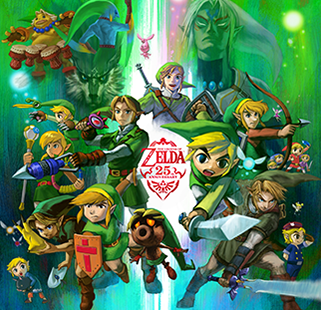
In most Zelda games, the player’s HP or life meter is represented by a line of hearts, each heart typically representing two hit points.
The Legend of Zelda games feature a boy named Link as the central playable character and protagonist. Link is frequently called upon to rescue Princess Zelda, after whom the series is named. The main antagonist in the series is a powerful creature known as Ganon, sometimes appearing as Ganondorf (the more recent villain Vaati has appeared in multiple Zelda games as well). The action usually occurs in the land of Hyrule and involves a divine relic known as the Triforce, a set of three magically bound golden triangles of great power. In story terms, the earlier games did not deviate much from the standard “save the princess” theme, but later installments have diversified their plot and added twists and turns to the tale. One Zelda game, Link’s Awakening, did not feature Zelda at all (although she was briefly mentioned), and in Majora’s Mask, she was only seen in a flashback. The protagonist in each game is not always the same boy named Link, although occasionally the same Link is controlled across multiple games (see “Nature of the protagonist”).
The games’ fantasy world of Hyrule includes many different climates and terrains, and is home to many different races and tribes of monsters and sentient beings. There are significant geographical differences from game to game, but several distinctive features recur, such as the Lost Woods, Lake Hylia, and Death Mountain (including Spectacle Rock near the summit).
The Zelda games feature a mixture of complex puzzles, strategic action gameplay, and exploration. These elements have remained fairly constant throughout the series, but with refinements and additions featured in each new game. This successful formula has been a primary factor in making the Zelda franchise one of Nintendo’s most successful game series. The player is frequently rewarded for solving complex puzzles or exhaustively exploring areas. The musical jingle when finding a hidden treasure (or other secret) has become one of video gaming’s most memorable themes.
Nearly every Zelda game involves locating and exploring maze-like dungeons until reaching the dungeon’s boss. Each dungeon generally has one special item hidden inside which will be required later in the game. Some items are found in almost every game, while others are exclusive to a single game (see ” Weapons and items from The Legend of Zelda series”). In the later games in the series, the item(s) found in each dungeon are usually used in some way to fight that dungeon’s boss.
The Legend of Zelda was principally inspired by Miyamoto’s explorations as a young boy in the hillsides surrounding his childhood home in Kyoto, where he ventured into forests with secluded lakes, caves, and rural villages. According to Miyamoto, one of his most memorable experiences was the discovery of a cave entrance in the middle of the woods. After some hesitation, he apprehensively entered the cave and explored its depths with the aid of a lantern. This memory has clearly influenced Miyamoto’s work, as cave exploration is a major element of most Zelda games. Other than Miyamoto’s childhood, Norse and Japanese mythologies have played a large role influencing the series, as well as Medieval European culture. Miyamoto has referred to the creation of the Zelda games as an attempt to bring to life a “miniature garden” for players to play with in each game of the series.
Hearing of F. Scott Fitzgerald’s wife Zelda, Mr. Miyamoto thought the name sounded “pleasant and significant.” Paying tribute, he chose to name the Princess after her, and titled his creation The Legend of Zelda, even though she is not the protagonist.
Credit : McGill
Picture Credit : Google




